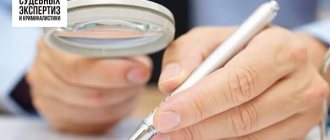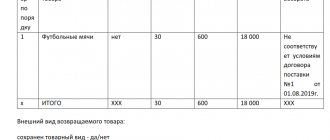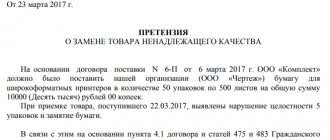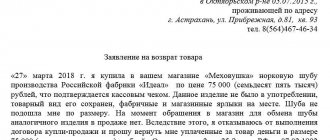Home / Complaints, courts, consumer rights / Consumer rights
Back
Published: 08/31/2018
Reading time: 8 min
0
1064
According to the legislation of the Russian Federation, the buyer has the right to return non-food products of inadequate quality under warranty for repair, exchange, refund, recalculation of cost, or receipt of certain compensation. At the same time, satisfaction of such requirements is possible only in cases where it is proven that the buyer was not involved in the occurrence of the defect that caused the return.
- Examination of goods of inadequate quality: concept, legal regulation, goals of the procedure
- Objectives of the examination
- Characteristics of the procedure
- Features and results of the procedure
- The procedure for conducting an examination of the quality of goods Presentation of goods
- Compiling and submitting an application
- Appointment of examination
- Expertise
- results
To establish the causes of the deficiency, as well as resolve other possible disputes in such situations, the legislation provides for the possibility of conducting an examination of the quality of the product.
Examination of goods of inadequate quality: concept, legal regulation, goals of the procedure
The rights and obligations of the parties arising from the purchase and sale of various goods (in this case, non-food durable goods) are regulated by the provisions of the Law of the Russian Federation No. 2300-1 “On the Protection of Consumer Rights” (hereinafter referred to as Law No. 2300-1), as well as a number of other regulatory legal acts.
According to Art. 18 of the said law, the seller (or other responsible party) is obliged to accept goods of inadequate quality from the buyer for replacement with an identical or similar one, free repair, recalculation of the cost or refund of money in accordance with the warranty conditions agreed upon at the time of purchase and fixed in the sales contract .
According to paragraph 5 of this article, the seller, if necessary, can check the quality of the goods on site in the presence of the buyer. In case of doubt or dispute regarding the occurrence of a defect that caused a return, the seller is obliged to initiate a technical examination of the quality of the product.
Quality examination in the context under consideration is a set of technical procedures carried out by a third party to check the serviceability, quality and compliance of a particular product of a certain brand, model and article with the declared parameters and characteristics. The initiator of the examination can be either the seller, the buyer, or another interested party.
What to do if your application is refused
The seller’s motivation is quite understandable, despite the fact that he is obliged to appoint an examination. In this case, it must be carried out by you, and then you need to go to court. Then you can also demand moral compensation. Another option is to contact the prosecutor’s office, because the store is violating your rights.
In any case, it is worth notifying the seller of your intentions not to stop and move on, and also provide a copy of the application; he may still decide to voluntarily sort out this situation.
Both food and non-food products can be subject to examination, but it is worth considering the expiration date of the product. Efficiency is required here so as not to hold out until the product is unsuitable for expert evaluation.
Dear readers! To solve your problem right now, get a free consultation
— contact the lawyer on duty in the online chat on the right or call: +7 (499) 938 6124 — Moscow and region.
+7 (812) 425 6761 — St. Petersburg and region. 8 (800) 350 8362 - Other regions of the Russian Federation You will not need to waste your time and nerves - an experienced lawyer will solve all your problems! Or describe the situation in the form below:
Objectives of the examination
The immediate objectives of the examination are:
- determination of the overall quality of the presented goods , as well as the nature of the existing shortcomings regarding the possibility of its full intended use;
- identifying the causes of existing deficiencies: establishing the presence of a manufacturing defect or violation of the rules of operation, transportation, storage, etc.
It is on the basis of the results of the study that the responsible party draws a conclusion about the causes of the malfunction and makes a decision on the possibility or impossibility of satisfying the buyer’s claim in accordance with legal requirements.
Nuances of interaction: buyer, seller and expert.
The consumer must bring the goods to the point of sale; delivery to the expert is paid by the store, provided that the consumer’s guilt in damaging the goods has not been proven.
The consumer must write an application, provide details of personal documents (passport), present a receipt, packaging (complete set) and indicate exactly what defects they found.
If a low-quality product is purchased, who pays for the examination? The seller orders and pays.
Provided that the examination has confirmed a manufacturing defect, damage received during unloading of the goods, storage in the store, but the administration of the retail outlet refuses to replace/compensate for the damage, the case is sent to court.
If the examination proves that the defect appeared due to the fault of the consumer, then he reimburses the costs incurred by the store.
Before filing a claim, the consumer can independently and at his own expense make a second examination, the results of which are attached to the claim.
The price of the examination depends on the product and the company that conducts it: the average price is from 3 to 50 thousand rubles.
Return of defective goods: consumer protection law.
Characteristics of the procedure
The examination of product quality is carried out by a third party, i.e., an independent public or private organization capable of providing unbiased and objective research results. Such an organization must have the appropriate authority (accreditation and a valid license), as well as the necessary resources - equipment, qualified personnel, etc.
In accordance with paragraph 5 of Art. 18 of Law No. 2300-1, examination of the quality of goods is carried out at the expense of the seller or other responsible party.
However, if the initiator of the examination is the buyer, the procedure is carried out at his expense.
The legislative framework
The legislative framework is based on the Law of the Russian Federation dated 02/07/1992 N 2300-1 (as amended on 04/18/2018) On the protection of consumer rights. In this case, all the provisions are spelled out in Article 18 - in what cases the buyer has the right to demand an examination, how it should be carried out, and who bears the losses.
Additionally, the following standards and acts are used:
- Article 25 of the already mentioned law - regulates the right to exchange goods of inadequate quality;
- Order of the Ministry of Agriculture of the Russian Federation dated May 6, 2008 N 238 - stipulates the rules for conducting examination of low-quality animal feed, in other words, it prescribes the specifics of conducting laboratory research;
- Decree of the Government of the Russian Federation of September 29, 1997 N 1263 - prescribes the requirements and rules for the examination of food products;
- Article 502 of the Civil Code of the Russian Federation - indicates the buyer’s right to return the product, exchange it or demand free repairs under warranty.
These are the main standards used in carrying out the procedure in question. Depending on the type of product, additional legislation may be involved.
Features and results of the procedure
The product quality examination itself is carried out in several stages (with special attention paid to the defect that caused the return):
- Functional Test: The product is tested to ensure that it meets the specifications and functions stated by the manufacturer and/or seller.
- External inspection: the product is examined for the safety of seals, the presence of any external damage, deformation or other defects.
- Internal inspection: the internal structure of the product is checked for compliance with technical documentation, the presence of any damage, as well as traces of contamination and contact with liquids.
Based on the inspection, the experts draw up a corresponding written conclusion on the reasons for the defect, i.e., they actually confirm or deny the buyer’s involvement in the defect he identified.
When is it required?
Product examination is required in the following cases:
- A disagreement arose between the parties regarding the determination of the cause of the product failure - both shift responsibility to each other.
- Returning a product is not possible until the cause of the breakdown is determined - often the seller accepts the purchase for examination and subsequent return to the manufacturer.
- There was a need to find out whether the purchase met the quality standards and regulations in force in Russia.
- During the operation of the purchase, the need arose to conduct laboratory research. In most cases, this occurs in relation to household chemicals or cosmetics - the user has an allergic reaction, which necessitates the need to identify the allergen.
- If the purchase has any defects that were discovered during use, buyers will want to find out how much the quality of the product has been lost. Often the seller offers to find out this, believing that you can use the purchase even if there are minor problems.
- The product does not correspond to the appearance declared by the manufacturer - you need to find out whether the product retains the built-in functionality.
- The buyer used the product, but decided to return it due to dissatisfaction - a determination of wear and tear on the product is required. This allows you to determine the markdown of the product, which is necessary when returning the product in full to the seller.
- If defects are discovered during use, it becomes necessary to determine the market value of the goods in order for the seller to pay compensation to the buyer.
These are the main reasons when an examination of a low-quality product is required. Depending on the situation, the procedure may be required in less significant cases.
The procedure for examining the quality of goods
The procedure for examining a defective product consists of the following stages:
- Presentation of goods of inadequate quality.
- Drawing up a return application.
- Appointment of examination.
- Direct examination.
- Obtaining examination results.
Presentation of goods
Products with identified defects are presented to representatives of the selling organization or other responsible party along with documents confirming the fact of purchase. After the buyer identifies any detected defects, authorized persons conduct an initial inspection of the goods on site.
Compiling and submitting an application
In addition to the goods and supporting documents, you must also present a corresponding application.
The text of the document indicates:
- addressee: name and head of the organization accepting the goods under warranty;
- applicant: full name, address and contact details of the buyer;
- description: date and place of purchase, nature of defects or inconsistencies found;
- the essence of the claim in accordance with legal requirements: return, exchange, recalculation, etc.;
- consent to conduct technical examination;
- applicant's signature and date of filing.
The application is drawn up in two copies. One is handed over to the authorized representative of the party responsible for the warranty obligations; on the second, the employee of the receiving party puts a mark on acceptance of the claim (signature, date, seal) and returns it to the buyer.
Appointment of examination
The examination of the presented goods is initiated by the receiving party if it is impossible to identify the cause of the malfunction on site.
According to legal requirements, the buyer must be notified in advance of the place and time of this event and has the right to be present at each stage.
Expertise
During the procedure, employees of the expert organization draw up a corresponding report, copies of which, upon completion of the product examination, are handed over to representatives of interested parties. The text of this document must contain:
- description of the accepted product: brand, model, article number, technical characteristics and parameters;
- information about responsible employees of the expert organization: full name and position;
- a detailed description of each stage of verification: serviceability of the product, its compliance with the declared functions and characteristics, safety of seals, the presence of any external and/or internal defects, etc.;
- comments and signatures of all participants in the procedure: experts, the buyer, as well as other persons whose presence at such events does not contradict the law;
- time and date of the procedure.
Any violations committed by experts during the procedure must be recorded in the “Comments” column, after which this document can be used as evidence of unlawful actions against the buyer in the event of subsequent legal proceedings.
results
Based on the results of the procedure, employees of the expert organization draw up a written conclusion, copies of which are also transferred to interested parties.
The text of the conclusion contains:
- data of the party that initiated the examination;
- date and time of the examination performed;
- information about the tested product;
- assessment and conclusions: expert opinion on the nature of the product deficiency, the probable causes of its occurrence, as well as its impact on the possibility of full-fledged intended use of the product.
Upon receipt of the expert opinion, the party responsible for warranty service makes a decision on the advisability of satisfying the claim received from the buyer.
In cases where the results of a product inspection indicate direct or indirect involvement of the buyer in the occurrence of a defect, he (the buyer) undertakes to reimburse the seller (or another party that initiated the examination) for all direct and associated costs of its implementation. In this case, the claims made by the buyer regarding the quality of the purchased goods lose their legal force.
In the same case, if the buyer does not agree with the results of the examination, he has the right to carry out a similar procedure independently by contacting another organization of the appropriate profile at his own expense. At the same time, representatives of the receiving party must also be notified of the place and time of the procedure.
What to check during an internal examination under 44-FZ
The main point that is considered during control activities is the proper quality and volume of supplied GWS.
Two types of quality checks are allowed:
- Continuous, which involves checking the entire product.
- Selective, in which a certain share of products is assessed, and the results apply to the entire volume of goods received from the supplier. The use of this approach should be determined by technical regulations, GOSTs, technical specifications, special delivery conditions, and a contract.
In addition to assessing the quality, the expert checks the completeness, markings, compliance of containers and packaging with the standards prescribed in technical regulations, GOSTs, and specifications.
Timing of the examination
In accordance with the provisions of Law No. 2300-1, the maximum permissible total period for carrying out all stages of the examination depends entirely on the nature of the claim made by the buyer on the basis of the guarantee.
The maximum period allotted for the examination is, by default, included in the period allotted by law for satisfying a specific claim.
In particular, according to the above law, the maximum permissible period for conducting an examination (depending on the specific claim) is:
- Clause 1 Art. 20: elimination of deficiencies – 45 days from receipt of the complaint. Depending on the circumstances, this period may be extended by mutual agreement of the parties.
- Clause 1 Art. 21: replacement of goods with an identical or similar one – 20 days. However, if a replacement product is not available, this period is 30 days from the date of receipt of the claim.
- Art. 22: cancellation of the purchase and sale transaction, recalculation of cost, compensation for losses - 10 days from the date of receipt of the claim.
Who can conduct an internal examination under 44-FZ
Internal examination of products accepted from a supplier under a contract can be carried out by any person. In 99 cases out of 100, the role of expert is played by an employee on the customer’s staff, or several such specialists. Also, your own inspection can be included in the responsibilities of the acceptance committee, procurement commission or contract service employees - then the inspection of GWS is carried out collegiately.
We emphasize that Law 44-FZ does not require that the examination be carried out by only one employee, so the buyer can choose the most suitable format for him.
Law 44-FZ does not establish requirements for employees carrying out examinations on behalf of the customer. However, similar conditions are provided for members of the procurement commission, contract managers, and specialists of the relevant service. Therefore, such customer employees cannot always boast of an education in the field of procurement, and may not even be related to the relevant subject area. However, it is they who bear the responsibility when accepting the goods by the customer based on the results of the examination. A particularly serious situation arises when the product does not meet the characteristics specified in the agreement.
You need to understand that during external and internal examinations under 44-FZ, the responsibility of specialists is recorded in different acts. For workers hired from outside, the legislation establishes administrative (Article 7.32.6 of the Code of Administrative Offenses of the Russian Federation) and criminal liability (Article 200.6 of the Criminal Code of the Russian Federation).
The above acts do not apply to the customer’s full-time specialists selected to carry out the inspection. The fact is that in the conceptual apparatus of Law 44-FZ they are not considered experts, expert organizations. These are officials who inspect products on behalf of the customer. Their mistakes are punished according to the law, and the measure depends on how serious the consequences of the mistake are.








